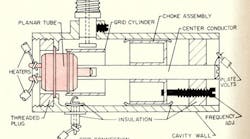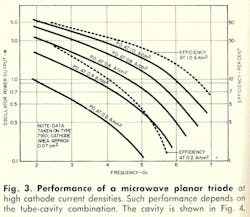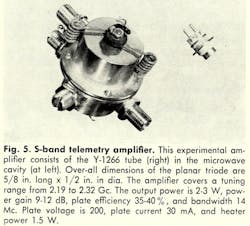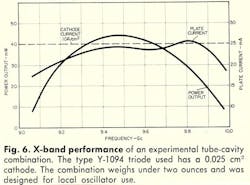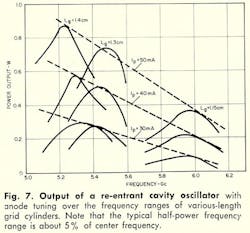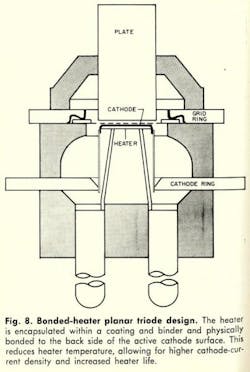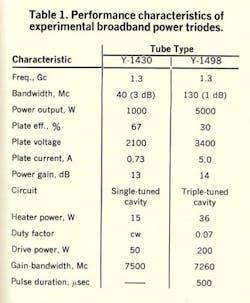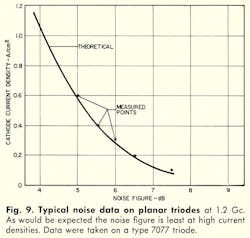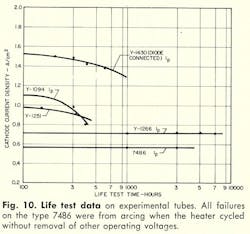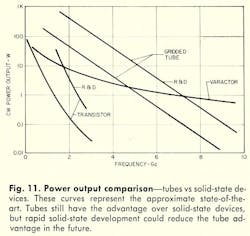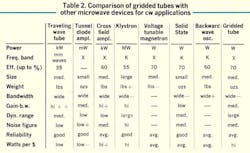May, 1967
The gridded tube has undergone an evolution. New mechanical shapes and dimensions and different operating levels have extended its useful upper frequency limit to about 10 Gc. At about 5 Gc, a tenfold increase in output power (to about 2 W) has been achieved over the last decade together with a fivefold improvement in efficiency (to about 15 percent). In the past two years, the life expectancy at 9.6 Gc has gone from 100-200 hours to 1000 hours at the higher cathode current densities (0.8 A/cm2).
These improvements have resulted in tube-cavity combinations of performance equal to that of reflex klystrons but at less cost. The latest gridded tubes have fast warmup (about 5 s) and require only simple power supplies.
For maximum usefulness at microwave frequencies, a triode must have minimum element-to-element spacings, the greatest possible cathode-current density and the highest possible anode voltage. Minimum size is also important in order to obtain low absolute values of tube inter-electrode capacitances. Generally these capacitances determine the maximum useful frequency, particularly when the tubes are used with quarter-wave resonant circuits. Minimum inductance is also important, which dictates that as much of the active RF circuit be outside the vacuum enclosure as possible.
This file type includes high resolution graphics and schematics when applicapable.
Planar design helps
Limits are approaching
Minimization of size and reduction of spacing seem to be nearing their practical limits. Closer spacing between grid and cathode offers no significant improvement in transmit-time loading, but it does limit the tube’s power input. Most microwave gridded-tube development is now concentrated on improving the effectiveness of cooling and mechanical construction to increase reliability and to allow higher operating voltages and currents. More efficient anodes are under development as well as more arc-resistant cathodes. Work is also being done on long-life cathodes with cw current densities up to 1.0 A/cm2—about a two-fold increase over present long-life designs.
From tests at lower frequencies, predictable oscillation requires an electron transit time of less than 5/6 cycle. Between 9 and 10 Gc, current densities of some 1.0 A/cm2 are necessary for about 1.0 percent plate efficiency. Recent work at 16 Gc confirms the predicted need for 2 to 3 A/cm2 for 1.0 percent efficiency at this frequency, evident from the curves in Fig. 2.
Tube-performance curves for a type 7910 planar triode are shown in Fig. 3. The data were obtained with the tube installed in a re-entrant coaxial-cavity oscillator, Fig. 4a, which permits adjustment of all important cavity variables. A simplified drawing of the tube-cavity combination is shown in Fig. 4b.
Measured performance of an experimental X-band tube-cavity combination is shown in Fig. 6. The triode used has a cathode area of about 0.025 cm2. This unit was designed for use as a local oscillator and weighs less than 2 oz including an integral X-band waveguide flange.
Tube-cavity mating—key performance
Optimum tube performance requires careful mating of the tube and its cavity. Up to about 2.5 Gc, the grid-separation grounded-grid amplifier (or oscillator) circuit is common. This is the condition where the grid physically and electrically separates the input and output circuits or cavities. A quarter-wave plate cavity is usually employed. The grid is grounded for RF, and there is a quarter-, half- or three-quarter-wave cathode circuit. The quarter-wave plate circuit is essential for broad-band amplifiers as this gives the maximum L-C ratio that yields minimum effective Q.
Amplifier considerations
This file type includes high resolution graphics and schematics when applicapable.
For broad-band operation, the cathode circuit need not be a single quarter wavelength. This is because of the high value of input capacitances usually encountered. Thus, input Q is very low even with multiple quarter-wave cathode circuits. In narrow-band circuits, where extra quarter wavelengths are sometimes desirable for frequency stability, they are employed only where size and weight permit. If the device is to be used as an oscillator, a feedback circuit is needed. This can be a capacitive, inductive or a combination probe between the cathode and plate cavities.
Above about 2.5 Gc, amplifiers become more difficult to build. Gains are lower because of transit-time loading, and noise figures are higher. Quarter-wave circuits are hard to build, particularly where they must be tuned; and there is little room for the proper output probe. Multi-quarter-wavelength circuits can be used but are generally undesirable because of their complexity. They are difficult to support mechanically, and special care is needed to prevent moding at lower frequencies. The gain-bandwidth product also decreases. For all these reasons, the practical upper design limit for gridded-tube amplifiers appears to be around 5 Gc.
Oscillator considerations
The planar-gridded tube has found most application in oscillators. Above about 2.5 Gc, the reentrant coaxial-cavity configuration (Fig. 4) is commonest. This is essentially a grounded cathode with a half-wave grid-anode circuit coupled to, and inside, the anode-cathode circuit. The anode-cathode circuit is usually full wave. It is often difficult physically to provide proper feedback relations with a simple half-wave and full-wave combination. Without the proper phase and amplitude relationships between the two circuits, oscillation may insufficient or may not occur at all. At higher microwave frequencies, best performance usually can be obtained by special means as follows:
The cathode can be operated off ground by mounting it at the end of a short low-impedance line at the cathode end of the tube-cavity combination. The line length is adjusted initially for best oscillator performance and appears uncritical from tube to tube. Also, over a 10-15 percent tuning range, variable adjustment of the grid-anode circuit is not needed. The tube-test cavity in Fig. 4 provides the means for tuning the cathode. The cathode assembly can be moved so that there will be a variable length of cathode line between the finger-stock short circuit and the triode’s cathode connection.
Another way to improve performance is to optimize the characteristic impedance of the grid-anode cavity. This can be done as shown in Fig. 4, where an “anode extension adjustment” has been added to the tuning plunger to move a larger center conductor in and out of the grid cylinder. The resulting change in cavity impedance changes the phasal relationship of the RF signal. The anode extension adjustment can be set for best feedback and oscillator efficiency. The curves in Fig. 3 were obtained with all variables optimized.
Good results have been obtained with these tube-cavity combinations using hybrid coaxial waveguide cavity circuits. A quarter- or half-wave grid-anode coaxial circuit is attached to the tube, after which it is inserted into a section of waveguide. The frequency is determined by the attached grid-anode circuit. Feedback is adjusted by tuning the ends of the waveguide section with tuning stubs or susceptance probes inserted into the waveguide walls. Output power is taken from the waveguide. Although its tuning range is quite limited, this circuit appears to be the most efficient and was the one employed to obtain power at 20 Gc.
Size of cavity
Cavity size depends on grid-anode tube capacity and is chosen as follows: At higher frequencies, (4-5 Gc approx.) the grid-cylinder ID and the anode line ID should be chosen such that their difference will be equal to or less than the length of the grid cylinder. This is desirable for suppression of unwanted modes. At lower frequencies (under about 1 Gc) it is common to choose the smallest ID of the cavity to minimize size and weight. The minimum cavity size is usually determined by the size of the tube. Thus, it is desirable to use the smallest practicable tube envelope.
Use of varactors
This file type includes high resolution graphics and schematics when applicapable.
Varactors have been used with tube-cavity combinations to obtain an electronically tuned oscillator for modulation and/or afc. The varactor is usually inserted as a susceptance stub into the high RF signal voltage point inside the cavity. The varactor Qs are low compared with cavity Qs, and a significant portion of the available output power is absorbed by the varactor. The useful tuning range appears to be about 1 percent and depends on both the degree of the varactor coupling and the amount of acceptable nonlinear tuning. As varactors improve, the useful electronic tuning range will increase.
Tube selection and use
Many tube types with similar shapes but different characteristics are available. The circuit designer is challenged to select the best tube for his application and should seek advice from all available sources. Many designs have internal features not immediately recognizable. A good example of this is the type Y-1124 bonded-heater planar triode shown schematically in Fig. 8. The heater is encapsulated inside a suitable coating and binder is physically bonded to the back of the active cathode surface. This greatly reduces the heater-wire temperature (the hottest spot in the tube), and results in longer life at higher current density and faster heater warm-up (3-5 s). The design gives extra mechanical ruggedness which helps with shock and vibration.
The important design considerations in selecting and using a gridded tube are:
- For best efficiency, choose the smallest tube with suitable ratings and power ouput.
- Pick the best tube geometry for the desired tube-cavity combination and the type of connectors to be used.
- Check for the desired thermal and mechanical capabilities.
- Determine that suitable power with sufficient regulation is available. Are isolated heaters necessary?
- For pulse applications, determine that sufficient peak emission is available for all possible heater voltages.
- For good gain-bandwidth, choose a tube with low capacitance and high transconductance.
- In high current-density applications, check for suitable tube stabilization for the desired early-life stability.
- Check tube and cavity stability over the desired temperature ranges when operating under shock and vibration.
- For maximum performance, several hours of prequalification operation is desirable.
- Derate as much as possible for longest life and best reliability.
- For cw applications using pulse rated types, reduce the heater voltage for longer life.
Higher-power broad-band tubes
- Over-all efficiency—15% min.
- Over-all gain—50 dB min.
- Pulsed power output—5 kW.
- Duty factor—0.07.
- Pulse duration—500 μs.
- Over-all size max—4- 1/2 x 4- 1/2 x 24 in.
- Over-all passband—1215 to 1400 Mc at 1 dB.
Noise figure and high current densities
Vacuum-tube noise performance is very dependent on the level of induced grid noise caused by transit-time effects. At any given frequency, the higher the current level the lower the noise figure. A typical relationship between noise figure and cathode-current density at 1.2 Gc is shown in Fig. 9. These data were obtained on a type 7077 planar triode. The higher the current densities, the greater the stage gain and useful dynamic range.
Factors in tube life
The practical limit for high-current-density operation depends primarily upon the extended tube life. Two basic problems are the ability to dissipate the heat generated and the maintenance of high-level emission at relatively low cathode temperatures. The first problem has been approached by design of special anode structures to provide efficient heat transfer from the tube.
Providing high cathode emission at relatively low cathode temperatures requires special effort. Some preliminary life test results measured on several types of tubes operating at high current density are shown in Fig. 10. These tubes required careful cathode processing and stabilization at bell-jar vacuum levels and very high temperatures.
The diodes show good life at high current densities. Triode life tests on the Y-1430 have not been completed. The 7486 data were taken at 450 Mc in an oscillator test circuit. Nine tubes were specifically stabilized for operation at the indicated current density prior to life test. The first tube failed at about 3000 hours; but the last of the nine was still operating at its original output power at 8500 hours. There was little change in power output for any of the tubes. All failures were from arcing, which was caused by heater-cycling without removal of other tube operating voltages. Power output was about 4.5 W.
The Y-1094 curve was obtained from X-band tests on one cavity. The power fell off at approximately the same rate as the tube plate current. The Y-1251 results were obtained at 5.7 Gc. Further heater-voltage optimization could have given better results. The Y-1266 life test was conducted in a unit oscillator at about 900 Mc. No noticeable change in power output was measured up to 5000 hours.
Gridded tubes vs. competing devices
This file type includes high resolution graphics and schematics when applicapable.
Small gridded-tube characteristics for cw applications are compared with other microwave devices in Table 2. For pulse work, transistors and varactors are not even in the running at the moment. The tube can be easily pulsed to provide a 1000-to-1 improvement in power output over cw conditions. Solid-state devices are not presently suited to pulse service; and in some cases, their maximum pulse voltages and currents cannot exceed the cw ratings.
Certainly a comparison of gridded tubes and solid-state devices is subject to change. The solid-state art is advancing rapidly, and any comparison could be obsolete before it was published. The current state-of-the-art is reflected in the curves of Fig. 11, which represent an updating of previously published curves.
Advantages of gridded triodes
Gridded tubes are applicable to many microwave systems. Features of these tubes include: low cost, small size and weight, simply circuitry, good tolerance to adverse environments, high pulse power output and low oscillator sideband noise (FM and AM), high gain-bandwidth at high power, high over-all efficiency at high frequencies, low cross and intermodulation and fast rise and fall times at high voltages.
Who makes them?
Aside from G.E., companies that possess ceramic planar-tube know-how include Amperex, Eimac Div. of Varian, Machlett, RCA, Siemens and Halske, and Sylvania.
Admittedly, some of the state-of-the-art described here is found only in experimental tubes. But demand could bring most of the indicated performance into the open.
